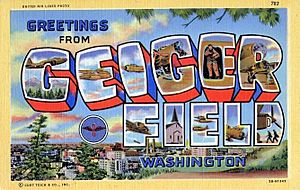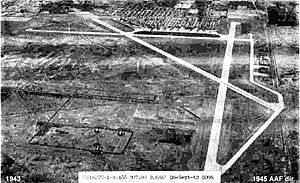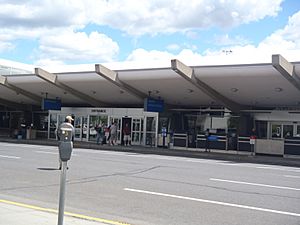Spokane International Airport facts for kids
Quick facts for kids
Spokane International Airport
Geiger Army Airfield
|
|||||||||||||||
|---|---|---|---|---|---|---|---|---|---|---|---|---|---|---|---|
 |
|||||||||||||||

Spokane International Airport in 2010,
viewed from the south |
|||||||||||||||
| Summary | |||||||||||||||
| Airport type | Public | ||||||||||||||
| Owner | Spokane County & City of Spokane | ||||||||||||||
| Operator | Spokane Airport Board | ||||||||||||||
| Serves | Inland Northwest (primarily Spokane–Coeur d'Alene area) | ||||||||||||||
| Location | West Hills, Spokane, Washington, United States | ||||||||||||||
| Hub for |
|
||||||||||||||
| Elevation AMSL | 2,385 ft / 727 m | ||||||||||||||
| Coordinates | 47°37′12″N 117°32′02″W / 47.62000°N 117.53389°W | ||||||||||||||
| Website | SpokaneAirports.net | ||||||||||||||
| Map | |||||||||||||||
 FAA airport diagram |
|||||||||||||||
| Runway | |||||||||||||||
|
|||||||||||||||
| Statistics (2024) | |||||||||||||||
|
|||||||||||||||
|
Source: Federal Aviation Administration; Spokane International Airport
|
|||||||||||||||
Spokane International Airport (GEG) is a busy airport in Spokane, Washington. It is about 7 miles (11 km) southwest of downtown Spokane. This airport is the main one for the Inland Northwest region. This area includes Spokane, the Tri-Cities, and Coeur d'Alene.
The airport's special code, GEG, comes from its old name, Geiger Field. This name honored Major Harold Geiger, an early aviation hero. In 2024, Spokane International Airport served over 4.2 million passengers. This makes it the second busiest airport in Washington state. Many airlines fly from GEG to more than 20 cities across the United States.
GEG is also the largest public airport in Washington state by land area. It covers about 6,140 acres (24.8 km²).
Contents
Airport History: From Field to Flights
Before 1941, the airport was called Sunset Field. The War Department bought it and renamed it Geiger Field. This was to honor Major Harold Geiger, who died in a plane crash in 1927.
During World War II, Geiger Field was a big training base. It helped train units that flew B-17 Flying Fortress planes. New planes came from Boeing near Seattle. The field also helped with plane repairs and supplies.
In 1943, a special fire protection training course started at Geiger Field. It was the first of its kind and was used until 1946.
Geiger Field closed in late 1945. It was then given to Spokane County. The county turned it into a commercial airport. In 1946, it became Spokane's main airport, replacing Felts Field.
The airport got its current name, Spokane International Airport, in 1960. This happened after the City of Spokane took over Geiger Field. The airport code is still GEG, remembering its past.
The main Concourse A and B building opened in 1965. It was designed by Warren C. Heylman and William Trogdon.
Growing Bigger: Airport Expansions
In 1974, a second level was added to Concourses A and B. This allowed planes to connect directly to the terminal with jet bridges.
The airport has a big plan for the future. This plan includes adding a third runway and more gates to Concourse C.
A new control tower was built south of the airport. It is the tallest control tower in Washington state. The airport also finished a big project in 2006. This project added shops, made security areas bigger, and updated the main Rotunda area.
In 2010, Runway 3–21 was made 2,000 feet (610 m) longer. This helps heavier planes take off, especially in summer.
By 2023, the airport planned to add new gates and a central security area. They also wanted more space for baggage claim. These changes help the airport handle more passengers and cargo.
Modernizing the Airport: TREX Program
On October 20, 2022, work began on a big project called the Terminal Renovation and Expansion (TREX) program. The first part of this project is making Concourse C larger. This $150 million addition will add 144,000 square feet (13,400 m²) and 6 new gates. It will also update the existing terminal.
The first part of the expanded Concourse C opened in June 2024. The rest of the project is expected to be finished in 2025.
The second part of the TREX program will create a central security checkpoint. It will also have a single, larger baggage claim area. This central connection will make it easier to move between Concourse A/B and Concourse C. This part of the project is planned to be built from 2025 to 2027.
The airport received $6.5 million from the 2021 Bipartisan Infrastructure Law. This money helps pay for these important projects.
Airport Features
Runways and Airfield
Spokane International Airport has two paved runways:
- Runway 3/21: 11,002 feet (3,353 m) long, made of asphalt and concrete.
- Runway 8/26: 8,199 feet (2,499 m) long, made of asphalt.
Control Tower
The airport's air traffic control tower is special. It is believed to be the only federally-run tower named after one person. This honor went to Ray Daves in 2010. Ray Daves was a World War II radioman who survived Pearl Harbor and Midway. He later worked as an air traffic controller in Spokane until the 1970s.
Terminal Buildings
Spokane International Airport has three main parts for passengers. These are Concourse A and B, Concourse C, and the Ground Transportation Center. These buildings are connected. However, passengers cannot walk directly between Concourse A-B and Concourse C without going through the public area.
Concourse A/B
The Concourse A/B complex opened in 1965. It has two concourses connected by a central rotunda. The rotunda has places to eat and shop. Concourse A has 5 gates (11-15), and Concourse B has 8 gates (1–8).
The building's design uses exposed concrete and unique shapes. Over the years, some parts of the original design have changed. For example, a second floor was added in 1974. This allowed for jet bridges to connect to planes.
Southwest Airlines mainly uses Concourse A. Delta and United Airlines use Concourse B. American Airlines used to be in Concourse B but moved to Concourse C in 2016.
Concourse C
Concourse C has 9 gates. Some are on the upper level (30-32) for larger planes. Others are on the lower level (21a, 21b, 22-26) for smaller regional planes. The current Concourse C opened in 2000 after a $20 million project. This project added 80,000 square feet (7,400 m²) and a new baggage claim area.
Concourse C has a modern look with lots of metal and large windows. It still uses some ideas from the older Concourse A and B design.
Alaska Airlines and Horizon Air were the main airlines here. But American Airlines moved to Concourse C in March 2016. Alaska and American use the upper gates, while Horizon uses the lower gates.
As of October 2022, Concourse C is being expanded as part of the TREX program. It is expected to fully reopen in late 2025.
Airlines and Destinations
Passenger Flights
| Airlines | Destinations |
|---|---|
| Alaska Airlines | Boise, Los Angeles, Portland (OR), San Diego, San Francisco, Seattle/Tacoma |
| Allegiant Air | Las Vegas, Los Angeles, Phoenix/Mesa |
| American Airlines | Chicago–O'Hare, Dallas/Fort Worth, Phoenix–Sky Harbor |
| Delta Air Lines | Atlanta, Minneapolis/St. Paul, Salt Lake City, Seattle/Tacoma |
| Delta Connection | Los Angeles, Salt Lake City, Seattle/Tacoma |
| Frontier Airlines | Denver |
| Southwest Airlines | Denver, Las Vegas, Oakland, Phoenix–Sky Harbor, Sacramento, San Jose (CA) Seasonal: Chicago–Midway, Dallas–Love |
| Sun Country Airlines | Seasonal: Minneapolis/St. Paul |
| United Airlines | Denver Seasonal: Chicago–O'Hare |
| United Express | Denver, San Francisco Seasonal: Chicago–O'Hare |
| Destinations map |
|---|
Cargo Flights
| Airlines | Destinations |
|---|---|
| AirPac Airlines | Ellensburg, Grangeville, Lewiston, Seattle–Boeing |
| Amazon Air | Lakeland |
| Ameriflight | Ephrata, Lewiston, Portland (OR), Seattle–Boeing, Seattle/Tacoma, Tri-Cities (WA), Wenatchee, Yakima |
| FedEx Express | Indianapolis, La Grande, Lewiston, Memphis, Moses Lake, Pendleton, Tri-Cities (WA), Wenatchee, Yakima |
| UPS Airlines | Dallas/Fort Worth, Des Moines, Louisville, Ontario, Portland (OR), Seattle–Boeing, Vancouver |
| Western Air Express | Boise, Portland (OR) |
Airport Statistics
Busiest Routes from GEG
| Rank | City | Passengers | Carriers |
|---|---|---|---|
| 1 | 525,000 | Alaska, Delta | |
| 2 | 245,460 | Southwest, United | |
| 3 | 165,740 | Delta | |
| 4 | 147,500 | American, Southwest | |
| 5 | 125,120 | Delta, Sun Country | |
| 6 | 100,540 | American | |
| 7 | 97,880 | Allegiant, Southwest | |
| 8 | 96,620 | Alaska | |
| 9 | 73,370 | Southwest | |
| 10 | 72,970 | Alaska, Delta |
Top Airlines at GEG
| Rank | Airline | Passengers | Share |
|---|---|---|---|
| 1 | Southwest Airlines | 946,000 | 23.09% |
| 2 | Delta Air Lines | 731,000 | 17.84% |
| 3 | SkyWest Airlines | 680,000 | 16.58% |
| 4 | Alaska Airlines | 592,000 | 14.45% |
| 5 | Horizon Air | 441,000 | 10.77% |
| Other | 707,000 | 17.26% |
Passenger Traffic Over the Years
| Year | Passengers | Year | Passengers | Year | Passengers | Year | Passengers | ||||||
|---|---|---|---|---|---|---|---|---|---|---|---|---|---|
| 1990 | 1,619,880 | 2000 | 3,068,890 | 2010 | 3,176,204 | 2020 | 1,926,159 | ||||||
| 1991 | 1,589,123 | 2001 | 2,880,186 | 2011 | 3,076,554 | 2021 | 3,280,062 | ||||||
| 1992 | 1,855,954 | 2002 | 2,745,788 | 2012 | 3,005,664 | 2022 | 3,920,972 | ||||||
| 1993 | 2,329,953 | 2003 | 2,789,505 | 2013 | 2,926,858 | 2023 | 4,131,266 | ||||||
| 1994 | 2,687,482 | 2004 | 3,059,069 | 2014 | 2,986,652 | 2024 | 4,264,875 | ||||||
| 1995 | 2,988,575 | 2005 | 3,197,440 | 2015 | 3,133,342 | 2025 | |||||||
| 1996 | 3,258,762 | 2006 | 3,224,423 | 2016 | 3,234,095 | 2026 | |||||||
| 1997 | 3,043,238 | 2007 | 3,471,901 | 2017 | 3,550,912 | 2027 | |||||||
| 1998 | 2,949,833 | 2008 | 3,423,500 | 2018 | 3,998,272 | 2019 | 4,036,920 | 2029 |
Getting To and From the Airport
Spokane Transit buses stop at Spokane International Airport. You can take routes 60 and 63. Other services like Travel Washington Gold Line and Northwestern Trailways also serve the airport.
A special building for rental cars opened in 2008. It is next to the Ground Transportation Center. This building helps handle all the rental car needs for passengers.
Past Incidents at the Airport
- On March 10, 1961, a U.S. Air Force F-106 plane crashed near Medical Lake while trying to land at Geiger Field. The pilot died.
- Six months later, on September 14, 1961, another U.S. Air Force F-106 crashed near Geiger Field. Its pilot also died.
- On February 18, 1972, a small plane (Cascade Airways Flight 325) crashed in fog while landing. All four people on board survived with minor injuries.
- On January 20, 1981, another Cascade Airways plane (Flight 201) crashed into a hill. Seven of the nine people on board died. The crash happened because of a mistake with the plane's navigation system.
- On March 18, 1994, a cargo plane (Douglas DC-3C) crashed shortly after taking off. Both pilots died. One of its engines failed.
- On January 4, 1996, a Convair CV-440 cargo plane had engine trouble while trying to land. It made a hard landing in a field and was badly damaged. Both people on board survived.
See also
 In Spanish: Aeropuerto Internacional de Spokane para niños
In Spanish: Aeropuerto Internacional de Spokane para niños
- List of airports in Washington








